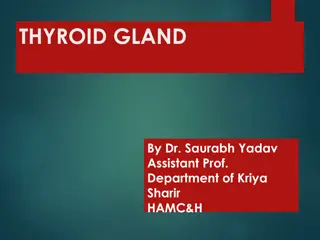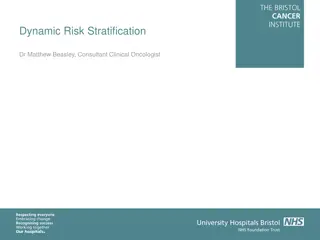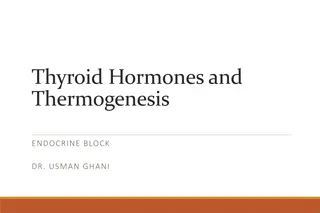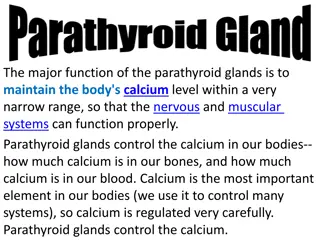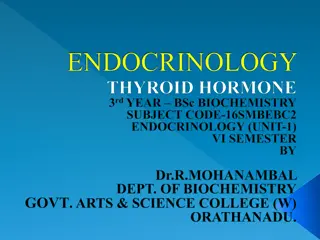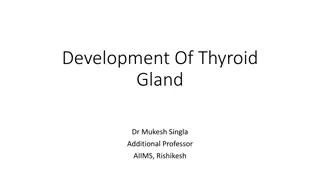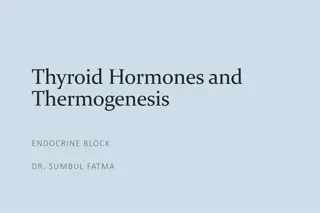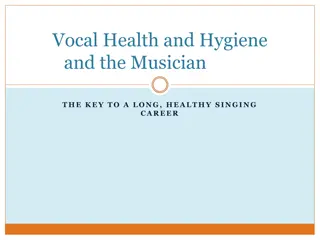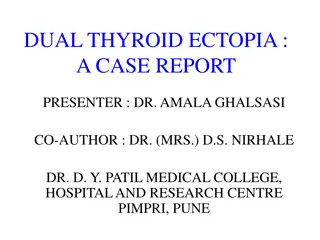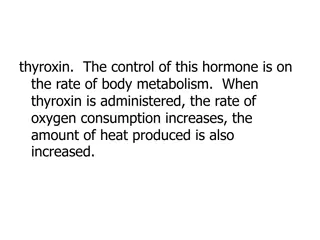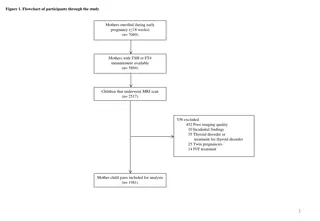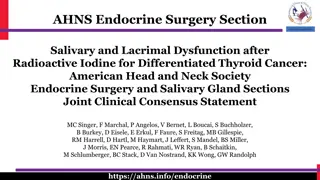Understanding Vocal Fold Paralysis and Neural Dysfunction After Thyroid and Parathyroid Surgery
This consensus statement by the American Head and Neck Society Endocrine Surgery Section highlights the importance of recognizing immediate vocal fold paralysis (VFP) and partial neural dysfunction (PND) following thyroid and parathyroid surgery. The report emphasizes the need for early identification, laryngeal examination, and prompt treatment to mitigate the impact on patients' quality of life. Vocal fold paralysis and neural dysfunction can lead to issues with voice, swallowing, and breathing, necessitating tailored evaluation and intervention strategies. The document sheds light on the complexity of laryngeal dysfunction, including factors beyond simple vocal fold paralysis, such as sensory and motor deficits. By defining these concepts and optimizing patient care, the aim is to enhance outcomes and minimize complications post-surgery.
Download Presentation

Please find below an Image/Link to download the presentation.
The content on the website is provided AS IS for your information and personal use only. It may not be sold, licensed, or shared on other websites without obtaining consent from the author. Download presentation by click this link. If you encounter any issues during the download, it is possible that the publisher has removed the file from their server.
E N D
Presentation Transcript
AHNS Endocrine Surgery Section Immediate and Partial Neural Dysfunction After Thyroid and Parathyroid Surgery: the Need for Recognition, Laryngeal Exam and Early Treatment An American Head and Neck Society Endocrine Surgery Section Consensus Statement VK Dhillon, GW Randolph, BC Stack, Jr., B Lindeman, G Bloom, CF Sinclair, G Woodson, JA Brooks, LF Childs, NH Esfandiari, L Evangelista, E Guardani, L Quintanilla-Dieck,, MR Naunheim, ML Shindo, M Singer, N Tolley, P Angelos, R Kupfer, V Banuchi, W Liddy, RP Tufano https://ahns.info/endocrine
AHNS Endocrine Surgery Section - https://ahns.info/endocrine
Consensus Development Consensus Author Panel National, multidisciplinary effort Members of AHNS Endocrine Surgery Section, endocrine surgeons, head and neck surgeons, laryngologists, speech language pathologist, endocrinologists, ThyCa member representative Recommendations Authors with expertise for respective sections Evidence based literature-publications from guidelines produced by the AAO, ATA and AHNS-Endocrine Section AHNS Endocrine Surgery Section - https://ahns.info/endocrine
Purpose To define immediate vocal fold paralysis (VFP) and partial neural dysfunction (PND) as clinically relevant concepts that identify laryngeal dysfunction that occur after thyroid and parathyroid surgery with significant quality of life impact for patients Identify subgroups of patients and optimize evaluation and treatment for patients with voice, swallowing and breathing issues after thyroid and parathyroid surgery AHNS Endocrine Surgery Section - https://ahns.info/endocrine
Background The reported rates of vocal fold paralysis (VFP) after thyroidectomy are a significant underestimate of its true incidence Vocal fold paralysis increases the risk for pneumonia, dysphagia, and increased risk for tracheostomy and gastrostomy tube as well as long-term mortality Laryngeal dysfunction is more complex than vocal fold paralysis. Encompasses sensory and motor dysfunction that can lead to symptoms of cough, globus sensation, dysphagia AHNS Endocrine Surgery Section - https://ahns.info/endocrine
Background Partial neural dysfunction includes recurrent laryngeal nerve (RLN) and superior laryngeal nerve (SLN) injury Efferent and afferent pathways involved in partial neural dysfunction include partial RLN dysfunction and partial or complete SLN dysfunction Significant psychosocial morbidity with VFP that can contribute to frustration, isolation, fear, and altered self- identity for patients Flexible laryngoscopy and videostroboscopy are important in identification and treatment of both, as well as early referral to Otolaryngology and Speech Language Pathology AHNS Endocrine Surgery Section - https://ahns.info/endocrine
Partial Neural Dysfunction Signs/Symptoms Motor dysfunction o RLN paresis, loss of tone, change in mucosal wave, paradoxical motion/laryngospasm, medial rotation of the arytenoid o SLN (external branch) change in pitch elevation, fine tuning of voice o Pharyngeal plexus dysphagia, loss of cricopharyngeal tone, globus sensation Sensory dysfunction o RLN loss of cervical esophageal sensation, dysphagia, cough o *SLN (internal branch)- cough, globus sensation *Internal branch of the SLN (IBSLN) is not typically at direct risk during thyroid or parathyroid surgery except for rare exceptions AHNS Endocrine Surgery Section - https://ahns.info/endocrine
Statement #1 The terms transient and permanent vocal fold paralysis do not capture all varying states of laryngeal dysfunction that can occur after thyroid and parathyroid surgery. Laryngeal dysfunction is complex and involves more than just vocal fold motion impairment. A comprehensive evaluation in the immediate post-operative setting is important if there is concern for any neural dysfunction. We therefore introduce the term immediate vocal fold paralysis AHNS Endocrine Surgery Section - https://ahns.info/endocrine
Vocal Fold Paralysis Impaired glottic closure caused by unilateral VFP in the immediate postoperative period can lead to significant functional deficits including communication impairment, dyspnea, and dysphagia. Bilateral VFP in the immediate post-operative period can lead to airway compromise and the need for emergent intervention Dysphonia, dysphagia and dyspnea are symptoms of vocal fold paralysis The identification of an immediate VFP enables early intervention in the form of patient counseling, voice therapy as well as early medialization procedures, or need for tracheostomy AHNS Endocrine Surgery Section - https://ahns.info/endocrine
Statement #2 Early identification, visualization and treatment of immediate post-operative neural dysfunction of the vocal fold, including vocal fold motion impairment, may allow for improved patient outcomes. Vocal fold examination in all of these patients should be performed in the immediate post-operative period which generally occurs within 2 weeks to 2 months AHNS Endocrine Surgery Section - https://ahns.info/endocrine
Early Identification of VFP The following intraoperative scenarios are consistently associated with immediate VFP and should be confirmed and documented by flexible laryngoscopy: 1) known transection or sacrifice of the RLN, or 2) no response to stimulation of the vagus or RLN with the use of nerve monitoring at the end of surgery Patients with known or suspected VFP, independent of symptoms, should undergo immediate evaluation and intervention even while admitted following thyroid or parathyroid surgery Direct visualization of immediate VFP assists in 1) identification and documentation of the VFP 2) intervention in a prompt fashion, and 3) counseling of patients with or without symptoms AHNS Endocrine Surgery Section - https://ahns.info/endocrine
Statement #3 Laryngeal nerve injury can affect afferent and efferent pathways, resulting in a spectrum of dysfunction. Partial neural dysfunction includes non-voice complaints and therefore may be underdiagnosed. Clinicians should have a high index of suspicion for partial neural dysfunction and involve Otolaryngology-Head and Neck Surgery and Speech Language Pathology colleagues if symptoms persist within 2 weeks to 2 months post- operatively, who may perform a voice and non- voice evaluation, as well as direct visualization of the larynx AHNS Endocrine Surgery Section - https://ahns.info/endocrine
Statement #4 A standardized approach in the work up for patients with immediate vocal fold paralysis and partial neural dysfunction should include an objective voice and swallow evaluation through validated questionnaires, direct visualization of the larynx as well as further testing if indicated. Such testing may include videostroboscopy, laryngeal electromyography and a modified barium swallow evaluation AHNS Endocrine Surgery Section - https://ahns.info/endocrine
Evaluation AHNS Endocrine Surgery Section - https://ahns.info/endocrine
Statement #5 Videostroboscopy provides important information for patients with immediate vocal fold paralysis and partial neural dysfunction. This may apply to those whose voice evaluation and symptom assessment are discordant from preliminary laryngoscopy findings, as well as those with documented neural dysfunction with or without voice complaints, including states of superior laryngeal nerve dysfunction AHNS Endocrine Surgery Section - https://ahns.info/endocrine
Videostroboscopy Videostroboscopy should be employed when subjective complaints are not reconciled by flexible laryngoscopy findings A comprehensive laryngeal examination is important to assess laryngeal dysfunction over an extended period of time, with the use of task specific exercises Early recognition of laryngeal dysfunction with appropriate specialists leads to improved patient counseling, and is beneficial and independent of the need for further treatment. This includes close patient follow up AHNS Endocrine Surgery Section - https://ahns.info/endocrine
Immediate and Partial Neural Dysfunction After Thyroid and Parathyroid Surgery: the Need for Recognition, Laryngeal Exam and Early Treatment An American Head and Neck Society Endocrine Surgery Section Consensus Statement VK Dhillon, GW Randolph, BC Stack, Jr., B Lindeman, G Bloom, CF Sinclair, G Woodson, JA Brooks, LF Childs, NH Esfandiari, L Evangelista, E Guardani, L Quintanilla-Dieck,, MR Naunheim, ML Shindo, M Singer, N Tolley, P Angelos, R Kupfer, V Banuchi, W Liddy, RP Tufano AHNS Endocrine Surgery Section - https://ahns.info/endocrine



